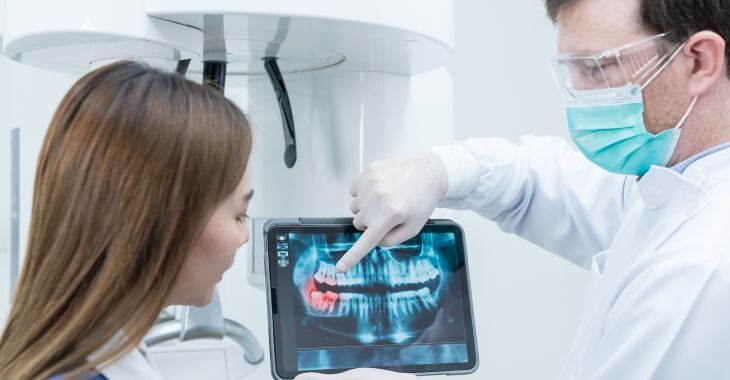What Causes Bone Loss in Teeth?

Bone loss in teeth is a serious dental concern that can lead to tooth instability, gum recession, and even facial structure changes. While many people associate bone problems with aging, the truth is that bone deterioration in the jaw can happen at any age without proper oral care.
Gum Disease: The Leading Cause of Bone Loss
The most common cause of bone loss in teeth is periodontal disease. This condition begins as mild gum inflammation called gingivitis. If untreated, it advances into periodontitis, where infection reaches deeper tissue and begins to erode the underlying bone.
When plaque and tartar accumulate at the gumline, harmful bacteria begin to spread under the gums. The body’s immune response triggers inflammation, which breaks down the tissue and bone supporting the teeth. Over time, this leads to bone degradation and tooth loosening.
According to the CDC, nearly 47% of adults over age 30 have some form of gum disease. Among adults over 65, that number rises to more than 70%. Many of these individuals experience varying degrees of bone loss in teeth, even if they haven’t lost a tooth yet.
Once the bacteria penetrate below the gumline, it becomes harder to clean, making the infection more aggressive. The longer it goes untreated, the more damage occurs. That’s why early detection and treatment of gum disease are critical to preserving bone.
Tooth Loss and Its Impact on the Jawbone
When a tooth is removed or falls out, the surrounding bone is no longer stimulated. This leads to a natural process called bone resorption. The body reabsorbs the unused bone tissue, causing the jaw to shrink and become weaker over time.
Studies show that 25% of bone volume is lost within the first year of a tooth being extracted. Without replacement, like a dental implant, the area continues to deteriorate. The change in facial structure can be noticeable in before and after bone loss in teeth comparisons.
Over time, jaw shrinkage can lead to sunken cheeks, reduced lip support, and difficulty eating. Denture wearers often notice changes in fit and comfort due to progressive bone loss beneath the gumline. Without intervention, options for repair become limited.
Replacing lost teeth with implants is one of the best ways to prevent additional bone loss. Dental implants mimic the root structure of natural teeth, stimulating the bone and maintaining its strength. The longer you wait to replace a missing tooth, the more bone you may lose.
Lifestyle and Health Factors That Contribute
Poor oral hygiene plays a major role in bone loss. Skipping brushing and flossing allows plaque to build up, fueling bacteria that inflame gums and destroy bone. Inconsistent dental visits also allow minor issues to progress into major oral health problems.
Smoking is another significant risk factor. Smokers are twice as likely to develop gum disease. Nicotine reduces blood flow to the gums, impairs healing, and suppresses the immune response. This accelerates the process of bone loss in teeth among tobacco users.
Certain health conditions also impact bone density in the jaw. Osteoporosis, diabetes, and autoimmune disorders weaken bones and tissues. Medications like steroids can also lower bone mass. These issues, when paired with poor oral care, drastically raise risk levels.
Bruxism, or chronic teeth grinding, causes micro-trauma to the periodontal ligament and supporting bone. Over time, this repeated pressure wears down bone tissue, even without signs of gum disease. Night guards and stress management can reduce this damage.
Genetics can’t be ignored either. Some people are naturally more prone to inflammation or bone loss in teeth. Even with good hygiene, they may develop problems earlier than others. A proactive dental routine and professional monitoring are crucial in these cases.
Prevention and Treatment Options
Fortunately, bone loss is not inevitable. With good habits and prompt treatment, it’s possible to slow or even reverse early-stage loss. Routine dental cleanings, proper brushing and flossing, and avoiding tobacco all help maintain bone health.
If gum disease is detected, deep cleaning methods like scaling and root planing can stop infection. These procedures remove bacteria from under the gumline and allow the tissue to heal. In moderate cases, bone grafting may be used to restore lost bone tissue.
For patients with severe loss, advanced treatments like guided tissue regeneration or ridge augmentation may be required. These options aim to rebuild lost bone structure and prepare the jaw for future restorations like implants or bridges.
Dental X-rays and 3D scans help monitor bone levels and detect early loss. At routine exams, your dentist evaluates your bone support and gum health to catch warning signs. With consistent care, the damage from bone loss in teeth can be managed and minimized.
Before and after bone loss in teeth, the difference in appearance and function is often dramatic. Early intervention makes a significant difference in preserving your smile, comfort, and confidence. It’s never too late to take action and protect your oral health.
Final Thoughts on Bone Loss in Teeth
Understanding what causes bone loss in teeth is the first step toward protecting your smile. From gum disease and tooth loss to medical conditions and lifestyle habits, many factors play a role. Fortunately, most causes are preventable or treatable with timely care.
Maintaining strong oral hygiene, attending regular checkups, and replacing missing teeth quickly can make all the difference. Whether you’re noticing early signs of gum disease or dealing with long-term bone issues, working with your dental provider is key.

Bone loss in teeth doesn’t just affect your mouth—it impacts your entire facial structure and overall health. Prioritize prevention and partner with your dentist to keep your jaw strong and your smile intact for the long haul.
The information provided on this website, including text, graphics, images, and other materials, is intended solely for informational purposes and should not be used as a substitute for professional medical advice, diagnosis, or treatment.




)